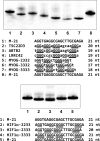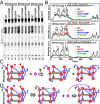Guanine-vacancy-bearing G-quadruplexes responsive to guanine derivatives
- PMID: 26553979
- PMCID: PMC4664295
- DOI: 10.1073/pnas.1516925112
Guanine-vacancy-bearing G-quadruplexes responsive to guanine derivatives
Abstract
G-quadruplex structures formed by guanine-rich nucleic acids are implicated in essential physiological and pathological processes and nanodevices. G-quadruplexes are normally composed of four Gn (n ≥ 3) tracts assembled into a core of multiple stacked G-quartet layers. By dimethyl sulfate footprinting, circular dichroism spectroscopy, thermal melting, and photo-cross-linking, here we describe a unique type of intramolecular G-quadruplex that forms with one G2 and three G3 tracts and bears a guanine vacancy (G-vacancy) in one of the G-quartet layers. The G-vacancy can be filled up by a guanine base from GTP or GMP to complete an intact G-quartet by Hoogsteen hydrogen bonding, resulting in significant G-quadruplex stabilization that can effectively alter DNA replication in vitro at physiological concentration of GTP and Mg(2+). A bioinformatic survey shows motifs of such G-quadruplexes are evolutionally selected in genes with unique distribution pattern in both eukaryotic and prokaryotic organisms, implying such G-vacancy-bearing G-quadruplexes are present and play a role in gene regulation. Because guanine derivatives are natural metabolites in cells, the formation of such G-quadruplexes and guanine fill-in (G-fill-in) may grant an environment-responsive regulation in cellular processes. Our findings thus not only expand the sequence definition of G-quadruplex formation, but more importantly, reveal a structural and functional property not seen in the standard canonical G-quadruplexes.
Keywords: G-quadruplex; G-vacancy; guanine-responsive; nucleic acids.
Conflict of interest statement
The authors declare no conflict of interest.
Figures


















Similar articles
-
Unfolding of G-quadruplexes: energetic, and ion and water contributions of G-quartet stacking.J Phys Chem B. 2006 Apr 6;110(13):6962-9. doi: 10.1021/jp0574697. J Phys Chem B. 2006. PMID: 16571009
-
The 3'-end region of the human PDGFR-β core promoter nuclease hypersensitive element forms a mixture of two unique end-insertion G-quadruplexes.Biochim Biophys Acta Gen Subj. 2018 Apr;1862(4):846-854. doi: 10.1016/j.bbagen.2017.12.011. Epub 2017 Dec 28. Biochim Biophys Acta Gen Subj. 2018. PMID: 29288770 Free PMC article.
-
Intramolecular and intermolecular guanine quadruplexes of DNA in aqueous salt and ethanol solutions.Biopolymers. 2007 May;86(1):1-10. doi: 10.1002/bip.20672. Biopolymers. 2007. PMID: 17211886
-
Quadruplex structures in nucleic acids.Biopolymers. 2000-2001;56(3):123-46. doi: 10.1002/1097-0282(2000/2001)56:3<123::AID-BIP10010>3.0.CO;2-3. Biopolymers. 2000. PMID: 11745109 Review.
-
Circular dichroism and guanine quadruplexes.Methods. 2012 May;57(1):64-75. doi: 10.1016/j.ymeth.2012.03.011. Epub 2012 Mar 17. Methods. 2012. PMID: 22450044 Review.
Cited by
-
QUFIND: tool for comparative prediction and mining of G4 quadruplexes overlapping with CpG islands.Front Genet. 2023 Oct 25;14:1265808. doi: 10.3389/fgene.2023.1265808. eCollection 2023. Front Genet. 2023. PMID: 37953924 Free PMC article.
-
An intermolecular G-quadruplex as the basis for GTP recognition in the class V-GTP aptamer.RNA. 2016 Nov;22(11):1750-1759. doi: 10.1261/rna.058909.116. Epub 2016 Sep 22. RNA. 2016. PMID: 27659052 Free PMC article.
-
G-quadruplex DNA: a novel target for drug design.Cell Mol Life Sci. 2021 Oct;78(19-20):6557-6583. doi: 10.1007/s00018-021-03921-8. Epub 2021 Aug 30. Cell Mol Life Sci. 2021. PMID: 34459951 Free PMC article. Review.
-
Detection of genomic G-quadruplexes in living cells using a small artificial protein.Nucleic Acids Res. 2020 Nov 18;48(20):11706-11720. doi: 10.1093/nar/gkaa841. Nucleic Acids Res. 2020. PMID: 33045726 Free PMC article.
-
A TeZla micromixer for interrogating the early and broad folding landscape of G-quadruplex via multistage velocity descending.Proc Natl Acad Sci U S A. 2024 Jan 23;121(4):e2315401121. doi: 10.1073/pnas.2315401121. Epub 2024 Jan 17. Proc Natl Acad Sci U S A. 2024. PMID: 38232280 Free PMC article.
References
-
- Tarsounas M, Tijsterman M. Genomes and G-quadruplexes: For better or for worse. J Mol Biol. 2013;425(23):4782–4789. - PubMed
Publication types
MeSH terms
Substances
LinkOut - more resources
Full Text Sources
Other Literature Sources

